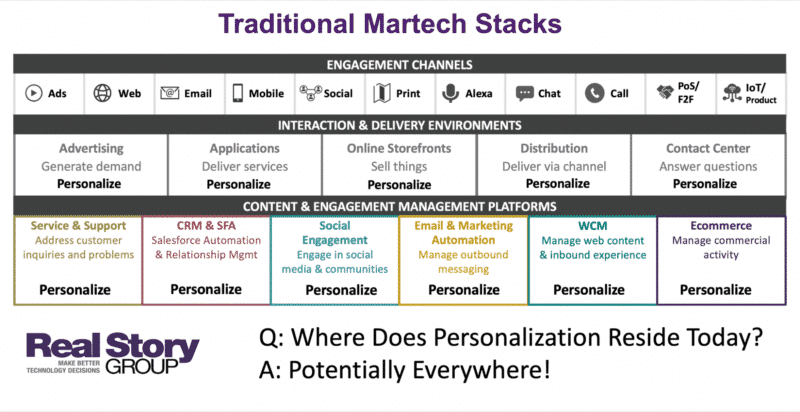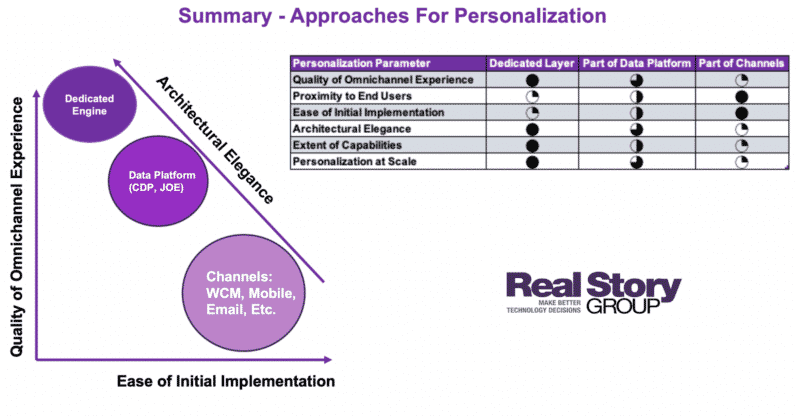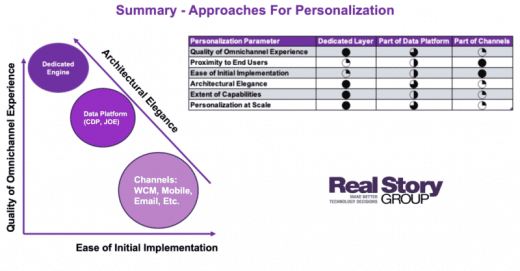The Real Story on MarTech: Where should personalization reside in your new stack?
This first of three articles on personalization at scale explores the right place for personalization services in your marketing technology stack
Online personalization as a concept has been with us for more than two decades, but recent developments have elevated its importance for martech leaders:
- Greater attention to test and optimization leading to demands for more “always-on” personalization programs;
- Better access to customer data and segments, opening up possibilities for more targeted experiences in any digital setting;
- Emergence of AI and ML-based approaches for automating personalization logic; and
- Heightened customer expectations for relevancy, leavened by experience with major consumer platforms like Netflix.
However, martech leaders today still struggle to implement personalization, even those at big companies with ample resources. And those who have gotten smarter about targeting people in individual channels must now confront the challenge of coherent personalization across an ever-growing set of channels.
This raises the first question to answer in my three-part series of articles on Personalization at Scale: Where should personalization reside in an omnichannel martech stack?
A legacy of silos
For the past two decades, that question went mostly unasked. Personalization just emerged as a possibility within distinct silos. Let’s dig a bit into the history here.
A modern martech stack consists of channels at the top, where you interact with prospects and customers. You then have interaction and delivery environments as well as engagement platforms underneath. During the 2000s and 2010s, this drove vendors at every level to build out personalization services within their discrete platforms, including:
- Web Content & Experience Management (WCM) platforms, to personalize content-heavy website experiences;
- Campaign Management and Outbound Marketing platforms, to personalize email and other messages;
- Ecommerce systems, to generated personalized shopping recommendations;
- CRM platforms to recommend next-best actions and conversations in a sales or support context;
- And so on…

Hence the legacy of personalization silos, with all the attendant disadvantages. Lacking an easy way to standardize or even align those rules everywhere, your targeting logic gets trapped in individual delivery channels. This in turn leads to incoherent and potentially frustrating customer experiences. A customer might get an offer in an email on a product that later she can’t find in your storefront, while searching your website in vain for further information, only to be delivered a different recommendation by your WCM platform. She calls a service rep who makes yet a different recommendation. Not good. But what are the alternative solutions?
Your options for seating personalization in your stack
There are at least three places in your stack where you can seat a personalization service. Of course, there is no single right answer, and you could mix and match different strategies for different scenarios.
1. Personalization in channels
This entails living with the status quo described above, and trying to optimize it as much as possible. In some cases, this strategy may still work well for you. First of all, it’s the easiest and fastest way to “grow into” personalized experiences, but you may find other benefits as well.
For example, this approach offers the tightest integration within your experience layer. So in your WCM platform you can very tightly couple your personalization logic with website content variants. Where content managers double as targeting managers, this can work very well.
The downside, as discussed above, is that you inevitably lose uniformity, consistency, or standardization across channels unless you muscle through with a lot of manual coordination, which typically isn’t sustainable.
2. Personalization as part of a data platform
The next option is to have personalization as part of an omnichannel data platform, such as a Customer Data Platform (CDP) or a Journey Orchestration Engine (JOE).
Several CDPs and almost all JOEs provide some subset of personalization capabilities built on top of their data management capabilities or as an integral part of their orchestration capabilities. In some cases the capabilities may prove light, but you get the benefit of operating them close to the all-important customer data. So, for example, if someone’s status changes — like a subscription expires — you can send them personalized win-back communications. Critically, you should be able to execute this across multiple platforms, including your call center, since the personalization logic isn’t “stuck” in any one channel.
There are downsides to this approach. Weaker integration with channels could lead to issues such as duplication of personalized content blocks. You may also encounter challenges trying to achieve bi-directional, real-time data exchange between your data layer and your engagement layer.
3. Personalization as a dedicated service
The last option is a dedicated personalization platform as a standalone tool in your stack. In some sense, this approach echoes the data-centric approach as it becomes a foundational service disconnected from any channel. Just remember that personalization works best when you have ready access to authoritative customer data, and so this approach does not obviate the need for unified, normalized, and accessible customer profiles.
The major benefit is that dedicated personalization engines can theoretically provide you a whole gamut of personalization capabilities – from multiple types of recommendations to testing of different types, and so on.
On the downside, RSG’s new Personalization Platform vendor evaluation research suggests that many of these solutions remain under-tested in the wider marketplace.
What you should do
As you can see, the three approaches bring their own trade-offs. Here’s a handy summary, based on RSG’s experience working with large enterprises.

In general these alternatives represent a kind of maturity spectrum, but also potentially a journey towards a more elegant (read scalable and sustainable) architecture.
Of course, these approaches are not mutually exclusive and we often see enterprises deploying them in combination. So for some tactical wins, you might apply channel-specific personalization, whereas in the longer term, or fpr more strategic, scalable, and omnichannel use cases, you might end up deploying a separate, dedicated platform layer.
Finally, personalization technology does not exist in a vacuum. For the next post in this series, I’ll look at the specific capabilities necessary to succeed with personalization at scale.
Real Story on MarTech is presented through a partnership between MarTech and Real Story Group, a vendor-agnostic research and advisory organization that helps enterprises make better marketing technology stack and platform selection decisions.
The post The Real Story on MarTech: Where should personalization reside in your new stack? appeared first on MarTech.
(50)



